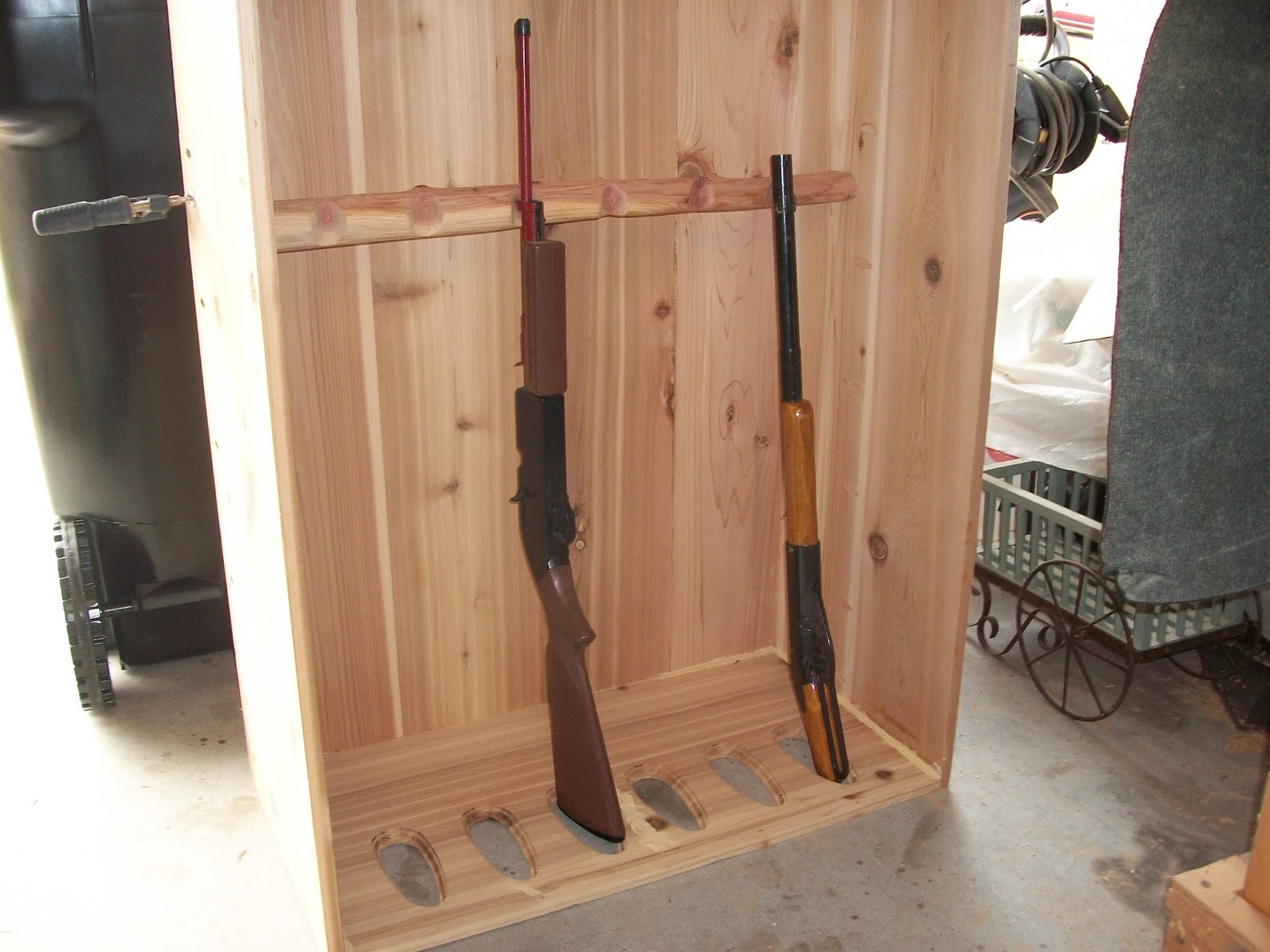Types of Wood Gun Cabinet Parts

Choosing the right wood for your gun cabinet is an important decision, as it will impact the durability, aesthetics, and overall value of your piece. Understanding the properties of different wood types can help you make an informed choice.
Wood Types for Gun Cabinets
The following table Artikels the pros and cons of commonly used wood types for gun cabinet construction:
| Wood Type | Durability | Cost | Aesthetic Appeal |
|---|---|---|---|
| Oak | High | Moderate | Classic, robust |
| Walnut | High | High | Rich, elegant |
| Cherry | Moderate | Moderate | Warm, reddish tones |
| Maple | Moderate | Moderate | Light, clean lines |
Hardware Components
Gun cabinets utilize a variety of hardware components to ensure security and functionality. These include:
| Component | Description |
|---|---|
| Hinges | Allow the door to open and close smoothly. |
| Locks | Secure the cabinet and protect its contents. |
| Shelves | Provide storage space for firearms and accessories. |
| Drawer Slides | Enable smooth operation of drawers. |
| Handles and Knobs | Allow for easy opening and closing of the cabinet. |
Finishes for Gun Cabinets
Finishes enhance the appearance and protect the wood from damage. Common finishes include:
- Oil-based finishes: Offer excellent durability and protection against moisture. Examples include tung oil and Danish oil.
- Polyurethane finishes: Known for their hardness and resistance to scratches and water.
- Lacquer finishes: Provide a high-gloss finish and offer good protection.
- Varnish finishes: Similar to lacquer, but may offer a more natural look.
Building a Wood Gun Cabinet

Building a wood gun cabinet is a rewarding project that combines woodworking skills with the satisfaction of creating a custom storage solution for your firearms. This project allows you to design a cabinet that meets your specific needs and preferences, while also adding a touch of personalized craftsmanship to your home.
Essential Tools and Materials
A well-equipped workshop is essential for building a sturdy and aesthetically pleasing gun cabinet. Here are the essential tools and materials you’ll need:
- Power tools: Table saw, circular saw, drill, jigsaw, router, sander
- Hand tools: Hammer, screwdriver, measuring tape, pencil, level, chisel, clamps
- Materials: Hardwood lumber (e.g., oak, maple, cherry), plywood, screws, nails, wood glue, finish (e.g., stain, paint, varnish), lockset, hinges
Planning and Cutting
Before starting the construction, it’s crucial to plan the dimensions and design of your gun cabinet. Consider the size and number of firearms you need to store, as well as the available space in your home.
- Draw a detailed plan: Sketch the cabinet’s dimensions, including the height, width, depth, and number of shelves. Include the location of the door, hinges, and lock.
- Cut the lumber: Using a table saw or circular saw, accurately cut the lumber to the required lengths. Ensure all cuts are precise to ensure proper assembly.
- Prepare the edges: Sand the edges of the lumber to create a smooth surface for assembly. This will also help prevent splintering during construction.
Assembly
Once you have all the pieces cut and prepared, you can start assembling the gun cabinet.
- Assemble the frame: Glue and screw together the sides, top, and bottom of the cabinet. Use clamps to ensure a strong and secure bond.
- Install the shelves: Cut the shelf boards to the desired length and width. Attach them to the cabinet frame using shelf supports or cleats.
- Attach the back panel: Cut a piece of plywood to fit the back of the cabinet and attach it using screws or nails.
- Install the door: Cut the door to size and attach the hinges. Ensure the hinges are aligned and secure before moving on.
Installing a Lock and Hinges
A sturdy lock and reliable hinges are essential for securing your firearms and preventing unauthorized access.
- Mark the lock location: Choose a suitable spot on the door for the lock and mark it with a pencil.
- Install the lock: Drill a hole for the lock cylinder and attach the lock plate to the door using screws. Ensure the lock is aligned with the strike plate on the cabinet frame.
- Install the hinges: Attach the hinges to the door and cabinet frame, ensuring they are aligned and secure. Use screws or rivets to fasten the hinges.
Applying a Protective Finish, Wood gun cabinet parts
A protective finish enhances the appearance of your gun cabinet while providing a durable surface that resists scratches, stains, and moisture.
- Sand the surface: Sand the entire cabinet using progressively finer grits of sandpaper to create a smooth and even surface. This will help the finish adhere properly.
- Apply the finish: Choose a finish that complements the wood and your desired level of protection. Apply the finish according to the manufacturer’s instructions, using a brush, roller, or spray gun.
- Let the finish dry: Allow the finish to dry completely before handling the cabinet. Multiple coats may be required for optimal protection.
Customizing a Wood Gun Cabinet
A wood gun cabinet is more than just a storage solution; it’s a statement piece that reflects your personality and style. Customizing your gun cabinet allows you to create a unique and functional piece of furniture that complements your home decor and enhances your gun collection.
Creative Customization Ideas
There are endless possibilities for customizing a wood gun cabinet. Here are some creative ideas to inspire you:
- Decorative Elements: Add decorative elements like moldings, trim, or inlays to enhance the aesthetic appeal of your cabinet. Consider using different wood species for accents, or incorporate metal accents like brass or copper for a touch of elegance.
- Carvings: Carvings can add a touch of artistry and sophistication to your gun cabinet. Choose intricate designs that complement the overall style of your cabinet, such as floral motifs, geometric patterns, or even wildlife scenes.
- Inlays: Inlays are decorative elements made from different materials, such as wood, metal, or stone, that are inlaid into the surface of the cabinet. They can be used to create intricate patterns, logos, or even personalized messages.
- Staining and Finishing: A wide range of stains and finishes are available to create the desired look for your gun cabinet. From traditional dark wood stains to modern light-colored finishes, the possibilities are endless. Consider using a clear coat to protect the wood and enhance its natural beauty.
Gun Cabinet Design Styles
Gun cabinets can be designed in a variety of styles to suit any taste and home decor. Here are a few popular options:
- Traditional Style: Traditional gun cabinets typically feature a classic, timeless design with ornate details, such as carvings, moldings, and dark wood stains. These cabinets are often made from high-quality hardwoods like cherry or mahogany.
- Modern Style: Modern gun cabinets are characterized by clean lines, minimalist designs, and a focus on functionality. They often feature sleek, contemporary finishes and may incorporate metal accents.
- Rustic Style: Rustic gun cabinets are designed to evoke a sense of warmth and natural beauty. They often feature distressed wood finishes, reclaimed materials, and rustic hardware.
Building a Custom Gun Cabinet
Building a custom gun cabinet allows you to create a piece of furniture that perfectly fits your specific dimensions and storage needs. Here are some tips for building a custom gun cabinet:
- Plan the Design: Start by sketching out your desired design and considering the dimensions, features, and materials you want to use.
- Choose the Right Wood: Select a wood that is strong, durable, and suitable for the style of your cabinet. Hardwoods like oak, maple, and cherry are popular choices for gun cabinets.
- Cut and Assemble the Parts: Using precise measurements and woodworking tools, cut and assemble the cabinet parts according to your design plan.
- Finish the Cabinet: Apply stain, paint, or a clear coat to finish the cabinet and protect the wood. Consider adding decorative elements or hardware to enhance the look.
Integrating Lighting
Proper lighting is essential for a gun cabinet, providing enhanced visibility and security. Here are some ways to integrate lighting into your gun cabinet:
- LED Strip Lights: LED strip lights can be easily installed inside the cabinet, providing bright, energy-efficient illumination.
- Recessed Lighting: Recessed lights can be incorporated into the cabinet design, providing a clean and professional look.
- Motion Sensor Lights: Motion sensor lights automatically turn on when the cabinet is opened, providing added security.
While the construction of wood gun cabinet parts may seem straightforward, the final aesthetic can be significantly impacted by the chosen finish. A smooth, even coat of paint can elevate the look of the cabinet, and the process of painting oak wood cabinets offers a wealth of knowledge that can be applied to gun cabinets as well.
By mastering the techniques of preparation, sanding, and applying paint, the wood gun cabinet parts can be transformed into a beautiful and functional piece of furniture.
The sleek lines and minimalist aesthetic of mid-century modern design have influenced many aspects of contemporary furniture, including the design of wood gun cabinets. While the focus on functionality and clean lines remains, modern gun cabinets often incorporate elements of traditional craftsmanship, using high-quality wood and intricate joinery techniques reminiscent of the mid century wood cabinet.
This blend of modern and traditional styles creates a timeless appeal, allowing these cabinets to seamlessly integrate into both contemporary and classic homes.
